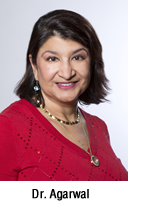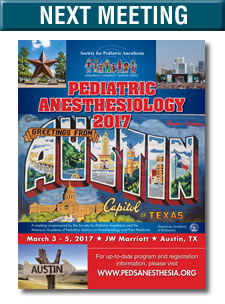American Academy of Pediatrics Section on Anesthesiology (AAP SOA) Review of Activities
 By Rita Agarwal, MD
By Rita Agarwal, MD
Chair, AAP Section on Anesthesiology and Pain Medicine (SOA)
Last October, Dr. Raeford Brown officially became Chair-Elect for the AAP SOA, and what an incredible addition he has been. Dr. Brown has been a long-time member of the Academy and serves as the current Chair of the FDA Subcommittee on Anesthesia and Analgesia. He has been involved with several major initiatives that will impact the Pediatric Anesthesiology community, including the Opioid Crisis and the FDA Warning on the Neurotoxicity of Anesthesia and Sedation in Children under three. He has led the efforts to temper the anxiety that has arisen from this warning and provide useful information for health care professionals and the public.
Education
The Section has continued its multipronged approach towards education including the writing and publishing of Clinical Statements and Guidelines for all physicians and other professionals caring for children. These include:
- A revision of the AAP/AAPD “Guidelines for Monitoring and Management of Pediatric Patients During and After Sedation for Diagnostic and Therapeutic Procedures: Update 2016” was published in Pediatrics in July 2016.
- A revision of the report on “Prevention and Management of Pain in the Neonate,” a joint effort with the Committee on Fetus and Newborn, was published in Pediatrics in February 2016.
- A new clinical report on “Codeine and the Potential for Toxicity in the Pediatric Patient,” a joint report with the Committee on Drugs, has been approved for publication in Pediatrics September 2016
In addition, the Section is working on:
- A revision of the statement on “The Assessment and Management of Acute Pain in Infants, Children, and Adolescents”; Drs. Corrie Anderson and Nathalia Jimenez are the lead authors ( this is in the review stages)
- A revision of the clinical report, “Interpretation of Do-Not-Attempt-Resuscitation and Resuscitation Limitation Orders for Pediatric Patients Who Require Anesthesia and Surgery,” a joint effort with the Section on Surgery and the Committee on Bioethics. Dr. Courtney Hardy is representing the SOA
- The Section has just submitted an intent for a new policy statement, “Peri-operative Management of Children with Sleep Disordered Breathing/Obstructive Sleep Apnea,” which will be a joint effort with the Section on Otolaryngology – Head and Neck Surgery. Drs. Anita Honkanen and Mahmoud Rehman are lead authors from our Section
- Intent for Clinical Report, Policy Statement or Technical Report: Oxymetazoline (Afrin): over the counter does not mean safe. Drs. Joseph Tobias, Richard Cartabuke
In the summer of 2016 there were two more webinars produced by the Section and the AAP Committee on Substance Abuse in association with the Providers' Clinical Support System for Opioid Therapies Grant from SAMHSA (http://pcss-o.org). These were the third and fourth offerings of a six-part webinar series aimed at prevention, identification, and treatment of opioid dependence. They are designed for primary care health care providers, but all clinicians are welcome to view them. Payment is required for CME, otherwise the information is free. The third Seminar was a discussion of managing youth. with co-occurring psychiatric issues and substance abuse by Drs. Pamela Gonzalez and Diane Diester (both psychiatrist in the Committee on Substance Abuse). A group that I certainly see in my inpatient pain practice You can view the slides, outline or the entire webinar at: http://pcss-o.org/event/co-occurring-psychiatric-illness-and-substance-use-in-youth/. As a mother of teenagers with ADHD, I found their talk terrifying and thought provoking. The 4th Seminar was by Dr. Stephen Hays and can be viewed here http://pcss-o.org/event/rational-pain-management-in-children-with-chronic-medical-conditions/ It is an excellent review of pain management in the child with chronic pain. Stay tuned for more information on Sessions 5 and 6 in 2017. Last year’s webinars by Drs. D’Souza and Golianu (Stanford University) and Dr. Breuner (Seattle Children’s Hospital) were extremely well received and are archived for future reference at http://tinyurl.com/hhof3hg.
In September, the online learning division of the Academy released the first module on Acute Pain Management sponsored by the Section. This module is written for pediatricians and pediatric subspecialists who often look to us for guidance in regards to appropriate and rationale pain management. Although only one CME credit is offered, it can be used towards fulfilling the requirement many states have for ongoing education regarding opioid prescribing for license renewal. Members and non-members of the AAP are encouraged to take the course, for most pediatric anesthesiologists this is an easy CME credit that can help fulfill licensing requirements.
Dr. Lisa Wise-Faberowski, presented a “Hot Topic” at the annual National Conference and Exhibition (NCE) in 2016, on Babies, Anesthesia and the Developing Brain, which was extremely well attended and received. Integrating Acupuncture into Pediatric Practice was another popular Workshop sponsored by the Section. A session on the Rationale Use of Opioids has been accepted for the NCE 2017.
I hope that many of you will be joining us for the 2017 SPA/AAP Pediatric Anesthesiology Meeting in Austin Texas, we have some great sessions planned, including the presentation of the Robert M Smith Award to Dr. Peter Davis from Pittsburgh Children’s Hospital. Please come and celebrate his extraordinarily influential career with us. Our AAP Advocacy Lecture will be on Bioethics in the Neonatal Intensive Care Unit. Our speaker is Dr. Anne Javier from Quebec. The Ask the Experts Panel will focus on Weird and Wonderful (in honor of Austin’s unofficial motto of Keep Austin Weird) Dr. Susan Goobie (Boston Children’s) will talk about blood conservation techniques in Craniofacial Reconstruction and Dr. Franklin Cladis will talk about “Challenging Craniofacial Syndromes”. The final offering from the SOA will be the John J. Downes Resident Research Awards for the top three abstracts from our trainees. These trainees will have an opportunity to present their work in front of a discerning audience and will hopefully be encouraged to continue their research. The John J. Downes awards and oral abstract presentations are given as part of the scientific session that also rewards young investigators (SPA Young Investigators Award) for their work.
Advocacy
The ongoing initiatives of the AAP Section on Anesthesiology & Pain Medicine continue to focus on the improved health and well-being of pediatric patients of all ages. The Academy will continue to work with the SPA and ASA on providing information to families, physicians and other Health Care Professionals on the safe use of anesthesia and sedation in young children. A series of FAQ’s is being developed to include on the Academy’s Healthy Children Website addressing some of these issues. Dr Raeford Brown has written an article on the topic for an upcoming issue of the AAP News. The AAP Surgical Advisory Panel, an expert panel made up of the Chairs of each of the surgical sections within the AAP, has established on Subcommittee on Optimal Timing of Surgery, to try to better delineate the appropriate time for surgery/procedures in children.
In March, each year the AAP holds its Annual Leadership Forum (affectionately known as ALF). At this meeting, one of the most important activities it undertakes is the evaluation of Resolutions. Any Section, Committee, Council, Chapter or District within the Academy can submit a resolution for consideration. These Resolutions are used to help guide the Academy’s activities for the upcoming year and are a useful way to allow the presentation of ideas, concerns and activities to the rest of the membership and potentially getting support from other Sections, Councils Committees etc. Acceptance of a Resolution is great, but having it accepted as one of the Top 10 is the goal. A top Ten Resolution means that the Academy, will prioritize this as one of its goals for the upcoming year. It lends its resources and infrastructure to helping accomplish the goals of the Resolution. This year there are two Resolutions the SOA is sponsoring or co-sponsoring. One is on the safe storage and disposal of leftover opioids, asking the Academy to educate pediatricians and other prescribers on rational prescriptions of opioids and the importance of counseling parents and patients on safely storing these medications and safely disposing them. The other is on the importance of qualified personnel providing anesthesia for children undergoing dental work.
In September 2016, the U.S. Food and Drug Administration (FDA) held a joint meeting of its Anesthetic and Analgesic Drug Products Advisory Committee (Chaired by Dr. Raeford Brown, SOA Chair –Elect) and its Drug Safety, Risk Management Advisory Committee and its Pediatric Advisory Committee. The AAP was represented by Drs. Raeford Brown, Constance Houck (Surgical Advisory Panel Chair, Committee on Drugs, Member) and Randall Flick (SPA President). Reviews of this meeting have been published in the AAP SOA and the SPPM Newsletters.
The ASA approached the AAP about support for the Perioperative Surgical Home (PSH) Learning Collaborative. After many teleconferences and much discussion, the SOA is supportive, however our surgical colleagues are seeking more information. They have been invited and plan to attend a PSH learning collaborative meeting in the future.
In October, a new taskforce of the Academy met for the first time. This is a Taskforce aimed at preventing injury]y with the ingestion of Button Batteries. Dr. Lisa Faberowski represented the Section at this meeting and both she and Dr. Debnath Chatterjee will be representing the SOA and the SPA in ongoing meetings. There are have been several reported deaths and serious complications with the ingestion of these batteries in young children; the taskforce is looking at ways to neutralize the toxic alkaline reaction and increase awareness of the danger of these ingestions. There will be more information available at the AAP Booth at the upcoming Pediatric Anesthesiology 2017 Meeting.
As always I appeal to all of you who are pediatric anesthesiologists to consider joining the AAP Section on Anesthesiology and Pain Medicine. We work with pediatricians, pediatric specialists and pediatric subspecialists to improve care and outcome for all children. The AAP has a phenomenal and well respected history in advocacy with the federal government and its agencies; it has been influential in many of the advances in pediatric medication research and FDA approval.





